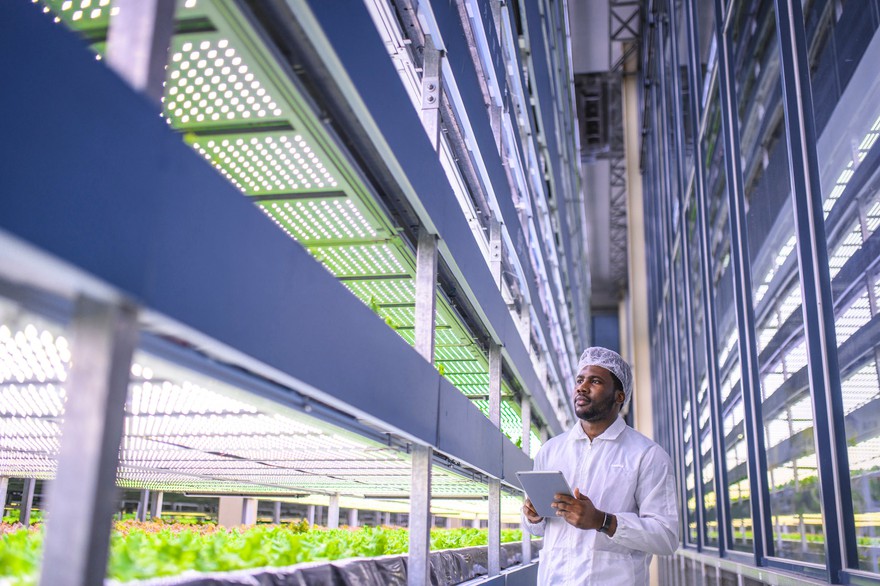With the global population continuing to expand, the world will need to double its food supply over the next three decades. That's a daunting task, especially as arable land for farming shrinks due to climate change, urban sprawl, and soil destruction. At the current pace, farmable land could fall 50% by 2050, making an already daunting challenge even tougher.
Since it's become more challenging to find additional farmland to meet our growing food needs, farmers are starting to go vertical. Here's a closer look at some of the agricultural companies focused on vertical farming.

Top vertical farming stocks in 2025
Vertical farming isn't a new technique. However, it's an emerging sector for those seeking more sustainable investments. There aren't too many publicly traded companies focused on the space yet, especially since a couple of notable ones have gone bankrupt in recent years. Here are some top options for investors to consider:
These are very small companies, which makes them highly risky. That disclaimer aside, here's a closer look at some of these indoor vertical farming stocks.
1. Local Bounti

NYSE: LOCL
Key Data Points
Local Bounti (LOCL -3.51%) is a controlled environment agriculture company. It utilizes its patented Stack & Flow Technology, which is a hybrid of vertical farming and hydroponic greenhouse farming. The company uses this process to grow healthy food sustainably and affordably. Its technique uses 90% less water and 90% less land than traditional farming methods.
The company grows living lettuce, herbs, and loose-leaf lettuce. It has six operational facilities and sells 27 retail products through more than 13,000 retail partners. The company is investing heavily in expanding its capacity and innovation. It has launched several new products, including spinach, arugula, and grab-and-go salad kits. Those investments have expanded the company's total addressable market opportunity to more than $75 billion.
2. Village Farms

NASDAQ: VFF
Key Data Points
Benefits and risks of vertical farming stocks
Investors need to understand the risks and benefits of vertical farming stocks before buying shares of a company focused on the sector. Some of the benefits include:
- Vital to the future of food: These companies could play a crucial role in helping to meet the world's growing demand for food, especially given the challenges of shrinking farmable acres.
- Meaningful growth potential: The sector has a lot of growth potential as companies like Local Bounti and Village Farms expand their farming operations. The expected growth will also benefit equipment and supply makers like Hydrofarm Holdings.
On the other hand, the sector has a higher risk profile than other industries, including:
- Nascent industry: The industry is still in its early days, so many vertical farming companies are very small.
- Financial risks: A couple of notable vertical farming stocks have declared bankruptcy in recent years due to unsustainable financials.
- Limited investment options: Only a handful of publicly traded companies focus on vertical farming, leaving investors with very few options.
The sector's growth potential makes vertical farming stocks interesting options for investors looking to get into this fast-growing space. However, they need to tread carefully when considering vertical farming stocks, given the sector's very high risk profile.
How to buy vertical farming stocks
Anyone can buy vertical farming stocks in their brokerage account. Here's a step-by-step guide on how to add one to your portfolio:
- Open your brokerage app: Log in to your brokerage account where you handle your investments.
- Search for the stock: Enter the ticker or company name into the search bar to bring up the stock's trading page.
- Decide how many shares to buy: Consider your investment goals and how much of your portfolio you want to allocate to this stock.
- Select order type: Choose between a market order to buy at the current price or a limit order to specify the maximum price you're willing to pay.
- Submit your order: Confirm the details and submit your buy order.
- Review your purchase: Check your portfolio to ensure your order was filled as expected and adjust your investment strategy accordingly.
Related investing topics
Future outlook and trends in vertical farming
A steadily rising population and an expanding global middle class are driving a growing need for food. At the same time, climate change and a steady decline in arable land due to urbanization are making it more difficult to grow food. These convergent trends bode well for the future of vertical farming. According to Spherical Insights, the vertical farming market is on track to grow at a more than 24% compound annual rate through 2030, reaching $26.4 billion. This growth should benefit companies focused on vertical farming.

